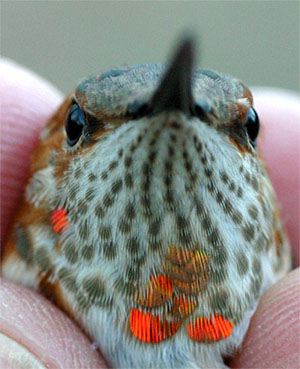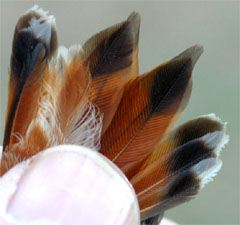|
|
|||
|
RUFOUS HUMMINGBIRD |
|
All text & photos © Hilton Pond Center On 9 December 2003 Dr. Lyle Campbell of the University of South Carolina-Spartanburg E-mailed us that--beginning sometime in November--an apparent Rufous Hummingbird had been visiting a feeder several miles from campus at the home of Bob and Willaminta Hight. Lyle was the tipster in 2002 for another hummer in the Boiling Springs area that we subsequently caught and confirmed as a hatch-year male Rufous.
We departed Hilton Pond Center an hour before dawn on the 22nd and arrived at the Hight residence in semi-darkness just at 7 a.m. We quickly moved the Hights' feeder into our portable hummingbird trap, re-hung it outside back window, and stepped inside where it was considerably warmer.
Within 20 minutes a hummingbird appeared, checked out the trap, entered, and was caught as we pushed the button on our remote mechanism. A rusty back and tail left no doubt that the Hights had been hosting a juvenile male Rufous Hummingbird, Selasphorus rufus, whose measurements are below.
Vital Statistics for
After completing all measurements and banding the Spartanburg hummer, we passed the bird to Mrs. Hight, who released it gently and watched as it flew to a nearly treetop. Then it was time to load up equipment and aim our van up I-26 for a trip toward Columbus NC--where we'd heard there was yet another winter vagrant hummingbird to be banded.
All text & photos © Hilton Pond Center
If you're interested in sharing your hummingbird observations and learning from other enthusiasts, you may wish to subscribe to Hummingbird Hobnob, our Yahoo!-based discussion group. Also be sure to visit our award-winning Web site for Operation RubyThroat: The Hummingbird Project; on it you'll find almost anything you want to know about hummingbirds, including more information about Hummingbird Banding.
For much more information about hummingbirds, visit Operation RubyThroat: The Hummingbird Project  |
|
Make direct donations on-line through
Network for Good: |
|
|
LIKE TO SHOP ON-LINE?
Donate a portion of your purchase price from 500+ top on-line stores via iGive: |
|
|
Use your PayPal account
to make direct donations: |
|
 post questions for The Piedmont Naturalist |
Join the |
Search Engine for |
|
|


 Unfortunately, the Hights were suffering from the flu during early and mid-December this year, so we temporarily deferred contacting them to set up a banding attempt. Eventually their health improved and we arranged to travel the 60 miles from our home base in York SC to Spartanburg (Spartanburg County) on the morning of 22 December, with the hope of verifying the species of the Hights' winter hummingbird.
Unfortunately, the Hights were suffering from the flu during early and mid-December this year, so we temporarily deferred contacting them to set up a banding attempt. Eventually their health improved and we arranged to travel the 60 miles from our home base in York SC to Spartanburg (Spartanburg County) on the morning of 22 December, with the hope of verifying the species of the Hights' winter hummingbird.





 Students at GLOBE-certified schools may submit winter hummingbird observations as part of Operation RubyThroat and GLOBE. Students can also correlate hummingbird observations with data on abiotic factors, including atmosphere, climate, hydrology, soils, land cover, and phenology. See the
Students at GLOBE-certified schools may submit winter hummingbird observations as part of Operation RubyThroat and GLOBE. Students can also correlate hummingbird observations with data on abiotic factors, including atmosphere, climate, hydrology, soils, land cover, and phenology. See the 

